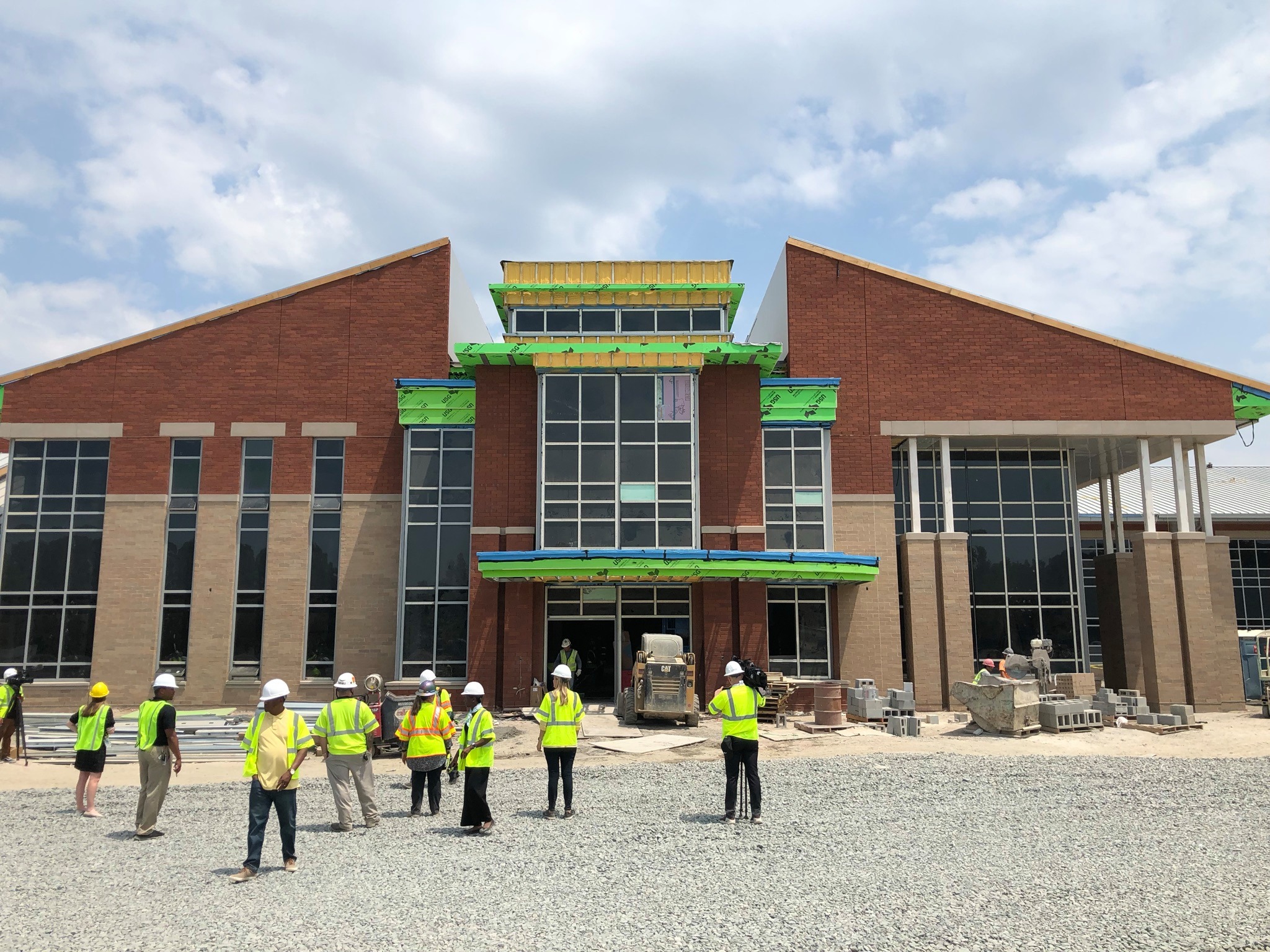A tour of the construction of the new Highland Springs High School in Henrico, estimated to cost about $80 million. (2021 photo Henrico County Public Schools)
By Nathaniel Cline
(VM) – According to state data related to school construction needs, Grayson, Franklin City, Martinsville, Bristol and Petersburg are the most financially strapped localities in Virginia.
The five have fiscal stress ratings of around 107. By contrast, many divisions in the more affluent Northern Virginia have scores of around 90.The state average is set at 100.
A school division’s financial situation is one of the major factors state officials consider in determining whether to provide a loan to help cover the costs of repairing and replacing aging buildings. More than half of all school buildings in Virginia are greater than 50 years old, according to a June 2021 presentation to the Commission on School Construction and Modernization.
Some common needs among school divisions are roof repairs and replacements, as well as safety upgrades and fixes for electrical and plumbing issues.
Additionally, the June report found 19% of schools failed to meet the requirements of the Americans with Disabilities Act, with estimated compliance costs totaling more than $204 million.
The biennial budget signed by Gov. Glenn Youngkin this August put $400 million into the state’s Literary Fund to be loaned out to local school divisions for construction projects at lower interest rates than previously allowed by law. However, some districts say the state’s criteria for those loans, which include the division’s ability to pay back the loan, has deterred them from seeking such assistance.
Jason Wood, superintendent of Patrick County Public Schools, said rural school divisions “would benefit more from additional grant opportunities, not loans that we cannot afford to repay.”
“Asking our taxpayers to take out another loan will be too burdensome when the majority of our local revenue already comes from property taxes,” he said. “Just as rural and small schools need a different funding formula to level the playing field with larger divisions, they also need additional help in school construction.”
Most portions of Patrick County’s schools date back to the late 1930s. The county also has one of the oldest collections of buildings in the state, with a median age of 82 years. At the same time, it has one of the state’s lowest composite index ratings, a measurement of a division’s ability to pay education costs, according to the latest data collected by the Virginia Department of Education.
While some divisions cannot seek assistance from the state’s Literary Fund because they cannot pay the loan back, others say they are constricted by a rule that prohibits divisions from getting Literary Fund loans to help cover the costs of projects that are already underway.
That’s the case in Floyd County, where the school division has one of the oldest groups of facilities in the state, with a median age of 75.5 years.
Floyd County Public Schools Superintendent John Wheeler said while the division was fortunate to be able to start on construction and renovation projects about four years ago when costs were lower, it is ineligible for a loan since its projects are underway.
Last session, with Virginia seeing record surpluses, lawmakers gave school divisions more options to get state funds for school construction and modernization.
The newly created School Construction Fund and Program offers competitive grants supported by appropriations from the general fund and literary funds, with ongoing funds to come from the newly authorized casino gambling in Virginia. This year, the new gaming proceeds fund is expected to receive $4.7 million from Virginia’s only operating casino, in Bristol, but casinos could generate up to $828 million in net revenue by 2028, when four casinos are expected to be up and running.
Under the School Construction Grants Program, a revived version of a program that existed prior to the Great Recession, schools receive funding based on a formula and can carry over those funds to future fiscal years. Recipients are determined through a scoring criteria developed by the Board of Education.That program received $400 million in funding this year.
The School Construction Assistance Program, which received $450 million in the budget, awards competitive grants to divisions that cover from 10 to 30% of project costs. The program prioritizes grants to divisions with poor building conditions and higher fiscal need, with recipients determined based on the local composite index and fiscal stress classification.
Prior to those investments, schools financed improvements with a combination of local revenues, bank loans, bonds and state and federal funds like Literary Fund loans.
Nine localities in Virginia, including Mecklenburg and Patrick counties, are allowed to impose a local sales and use tax to fund school construction projects. Efforts to allow more local governments to levy such taxes failed in a House subcommittee during the last General Assembly session.
Legislation to create incentives for local governing bodies and school boards to set aside funds not spent in a school year for maintenance, renovation or construction projects also failed during the same session.
Keith Perrigan, superintendent of Bristol Virginia Public Schools and president of the Coalition of Small and Rural Schools in Virginia, said he and other advocates are asking the General Assembly to make adjustments to how the state awards funds for construction costs. One recommendation is to make all construction projects that were either started or are completed during the current biennium eligible for the School Construction Assistance Program.
That, said Perrigan, “will provide much-needed resources to high-poverty school divisions.”
Ken Nicely, superintendent of Roanoke County Public Schools, said the school division will qualify for $100,000 from the School Construction Assistance Program based on its composite index. However, he’s concerned Roanoke will not meet the criteria for grant funds due to the way different factors such as need and building condition are scored.
“We will still apply for the grant in order to express interest and true need, but we are concerned that our projects will not score high enough due to the manner in which the point values were assigned,” Nicely said.
He said he hopes that the criteria will be adjusted for future competitive grants in order to allow divisions to complete and additional funds will be appropriated by the General Assembly for the formula grants.



